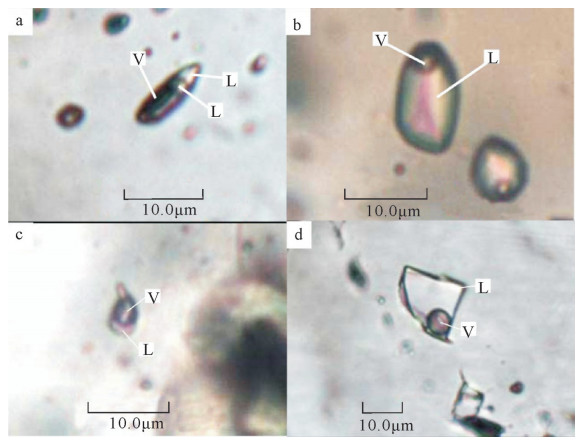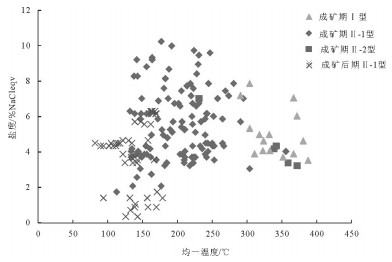Fluid inclusion studies of the Changpai area in Zhuguang Mountain, northern Guangdong Province
-
摘要:
长排矿区位于诸广山岩体南部,是近年来铀矿找矿重点突破的新成果。流体包裹体岩相学特征显示,该矿区成矿期主要发育2种类型包裹体:含CO2三相包裹体(Ⅰ型)和气液两相包裹体(Ⅱ型)。其中,Ⅱ型包裹体又可分为富液相包裹体(Ⅱ-1型)和富气相包裹体(Ⅱ-2型)。根据流体包裹体岩相学特征和显微测温结果,可将成矿期流体包裹体划分为2组:第1组均一温度主要集中在291~388℃之间,盐度范围为3.23%~7.87% NaCleqv,为Ⅰ型含CO2三相和Ⅱ-2型富气相包裹体;第2组均一温度范围主要集中于140~260℃之间,盐度为1.74%~10.24% NaCleqv,属Ⅱ-1型富液相包裹体,分别代表成矿期早阶段和晚阶段流体性质。晚阶段流体包裹体相对于早阶段具有较低的均一温度和较大的盐度变化范围,说明成矿期晚阶段很可能发生了不同来源流体的混合作用。激光拉曼分析显示,成矿期流体包裹体气相成分主要为CO2、CH4、H2等。硫同位素分析结果显示,成矿期黄铁矿δ34S值在-10.2‰~-3.2‰之间,与华南地区其他铀矿床成矿期硫化物的δ34S值相近。结合区域地质特征可知,长排矿区成矿物质主要来源于古老含铀地层部分熔融形成的富铀花岗岩;温度降低和流体混合作用可能是导致铀络合物水解沉淀的重要因素。
Abstract:The Changpai area, located within the southern part of the Zhuguang Mountain, is an important prospecting area in South China. In this paper, the authors present new fluid inclusion and stable isotopic data of the study area to discuss the nature of the oreforming fluids and uranium mineralization. Two types of fluid inclusions of the mineralization stage were recognized by petrographic observations:three-phase CO2-rich (type Ⅰ) and two-phase vapor-liquid (type Ⅱ) fluid inclusions. Type Ⅱ fluid inclusions include two sub-types, i.e. liquid-rich (type Ⅱ-1) and vapor-rich (type Ⅱ-2). Based on petrographic features and the results of microthermometry, the fluid inclusions from the mineralization stage can be classified into two suites:(1) type Ⅰ and Ⅱ-2 fluid inclusions with homogenization temperatures of 291~388℃ and salinities of 3.23%~7.87% NaCl equivalent; (2) type Ⅱ-1 fluid inclusions with homogenization temperatures of 140~260℃ and salinities of 1.74%~10.24% NaCl equivalent. The fluid inclusions of suite 1 and 2 represent the early and late sub-stages of fluids during the mineralization stage, respectively. Raman analyses of fluid inclusions show that the vapor ingredient of the ore-forming fluid inclusions contains CO 2, CH4 and H2. S isotopic compositions (δ34S=-10.2‰~-3.2‰) of the pyrites associated uranium mineralization are similar to those from other U deposits in South China. The fluid inclusions of suite 2 are characterized by wide range of salinities and have lower homogenization temperatures than those of suite 1, indicating that fluid mixing process took place. Combined with geological features, the authors hold that U was derived from the granite which was associated with partial melting of uranium-rich ancient crust, and that temperatures declining and fluid mixing played a key role in U precipitation.
-
Keywords:
- fluid inclusion /
- Raman spectroscopy /
- S isotope /
- Changpai area /
- Zhuguang Mountain
-
花岗岩型铀矿床是中国重要的铀矿床类型,主要分布于华南地区,目前占中国已探明铀资源量的22.9%[1-6]。华南地区花岗岩型铀矿床主要产于花岗岩体内部或外接触带附近,受断裂构造控制[7-8]。鉴于其成因类型属于热液型铀矿床[9],因此成矿流体始终是探讨该地区铀成矿作用过程最重要和最直接的手段[10-13]。
桃山-诸广山铀成矿带位于南岭地区,是中国最大的花岗岩型铀成矿带[14],其预测资源量占整个花岗岩型铀矿床预测资源量的50%[6],长期以来一直是学者们关注的焦点[15-17]。长排矿区位于诸广山岩体南缘长江铀矿田中部,毗邻著名的棉花坑(302)铀矿床,被认为是桃山-诸广山铀成矿带最具找矿潜力的地区之一。前人对该矿区开展了大量的岩石学、年代学、找矿勘查等方面的研究工作[18-20],但关于成矿作用和成矿机制方面的研究则较少。众所周知,流体包裹体研究可以查明成矿流体性质和成矿物质沉积机制,是研究成矿作用和成矿机制的重要手段[21-24]。因此,本文选择长排矿区开展流体包裹体及同位素研究,通过查明成矿流体的性质并探讨其成矿机制,为总结区域成矿规律和找矿提供依据。
1. 区域及矿区地质特征
诸广山地区位于广东、湖南和江西三省交界处,以出露巨型诸广山花岗岩岩基为特点。诸广山花岗岩位于该区中部,产状受南岭东西向构造和诸广山南北向构造的联合控制[25]。诸广山花岗岩体主要为过铝质花岗岩,岩性有二云母花岗岩、黑云母花岗岩、二长花岗岩等。区内地层多分布于诸广山岩体边部,主要包括:震旦系、寒武系、奥陶系变质砂岩、泥岩;泥盆系、石炭系灰岩和砂岩;白垩系—新近系碎屑岩[26]。长江矿田位于诸广山地区中部,是中国重要的铀矿田之一。该矿田以出露白垩纪、侏罗纪和三叠纪花岗岩为主,几乎未见地层露头。区内构造由NE—SW向、NW—SE向、N—S向和E—W向断裂构造组成,由北向南还分布有NE— SW向的里周、棉花坑和黄溪水断裂及NW—SE向的油洞断裂4条区域性断裂(图 1)。
![]() 图 1 长江铀矿田及长排矿区地质图(据参考文献[26]修改)Figure 1. Geological map of the Changjiang Uranium ore district and Changpai area
图 1 长江铀矿田及长排矿区地质图(据参考文献[26]修改)Figure 1. Geological map of the Changjiang Uranium ore district and Changpai area长排矿区位于长江铀矿田中部,其北接棉花坑铀矿床,受油洞断裂控制(图 1)。区内出露的侵入岩体主要为油洞岩体和长江岩体,其次为中基性岩脉等。油洞岩体形成于印支期,岩性主要为中粒小斑状二云母花岗岩。长江岩体形成于燕山期,呈岩基状产出,岩性主要为中粒黑云母花岗岩,局部出露细粒不等粒黑云母花岗岩,与毗邻油洞岩体呈侵入接触。长排矿区铀矿化严格受断裂控制,矿体产于NW向油洞断裂及NNW向断裂中。矿区硅化、赤铁矿化、黄铁矿化、紫黑色萤石化等蚀变与矿化关系密切,且具有水平分带特征,即由构造带中心向外侧依次为硅化→赤铁矿化→绢云母化→粘土化。矿石矿物主要为沥青铀矿,多呈脉状、浸染状构造。根据矿物组合可将长排矿区矿化期次划分为成矿前期、成矿期和成矿后期。其中,成矿前期以形成白色石英脉为主要特点;成矿期主要形成灰色微晶石英沥青铀矿、红色微晶石英沥青铀矿、萤石、黄铁矿等;成矿后期主要为白色石英及少量萤石。
2. 样品采集及分析方法
2.1 样品特征
进行流体包裹体测温的10件样品分别采自长排矿区7号(ZK304- 3)、61号(ZK41- 1)和9号(ZK11-2,ZK223-1,ZK4-3)富矿带中,其中成矿期样品来自钻孔ZK11-2,ZK4-3,ZK41-1,是发育于蚀变花岗岩中的灰色-红色石英脉、紫黑色萤石脉;成矿后期样品来自钻孔ZK11- 2,ZK304- 3,ZK223-1,主要为淡绿(紫)色和白色方解石脉。硫同位素样品均采于长排矿区9号带南段的钻孔ZK11-2中。样品为产于不同深度含矿花岗岩中的成矿期黄铁矿,多为细粒结构、团块状构造。
2.2 流体包裹体显微测温和激光拉曼分析
流体包裹体显微测温工作在中国地质大学(北京)地球化学教研室流体包裹体实验室完成。测试仪器为LINK THMSGS 600型冷热台,显微测温采用标准物质(KNO3、K2CrO3、CCl4)及人工配制的NaCl标准溶液对仪器进行温度标定,测定温度范围为-196~600℃,测试环境始终保持在25℃左右。包裹体测定时选用的显微镜倍数为500倍,首先利用液氮对包裹体进行降温,并观察包裹体的变化,包裹体被冷冻后,缓慢升温,当接近相变点时,减慢升温速率至0.1℃/min,记录冰点温度;继续升温,观察相态变化,当接近相变点时,减慢升温速率至0.5℃/ min或1℃/min,记录笼形物消失温度、部分均一温度和完全均一温度。均一温度误差为1℃,冰点温度误差为0.1℃。NaCl-H2O体系盐度根据NaClH2O型流体包裹体在冰点与盐度关系表中查得[27],密度值根据经验公式计算求得[28]。
流体包裹体激光拉曼分析在核工业北京地质研究院分析测试所实验室进行,测试仪器为LABHR-VISLabRAM HR800型显微激光拉曼光谱仪,扫描范围为100~4200cm-1,波长为532nm,湿度为50%,测试环境为25℃。
2.3 硫同位素分析
硫同位素分析在核工业北京地质研究院分析测试中心完成。以Cu2O做氧化剂制备测试样品,仪器型号为Finnigan MAT-251型质谱仪,分析结果采用国际标准CDT表达,分析精度优于0.2‰。
3. 分析结果
3.1 流体包裹体岩相学特征
本次重点对成矿期和成矿后期的石英、萤石及方解石中的流体包裹体进行了岩相学观察和显微测温实验。根据室温下流体包裹体岩相学特征,可将原生包裹体分为2种类型:含CO2三相包裹体(Ⅰ型:VCO2 + LCO2 +LH2O)和气液两相包裹体(Ⅱ型:V+L)(图 2)。
Ⅰ型:含CO2三相包裹体(VCO2 + LCO2 +LH2O),室温下(25℃)可见到液相CO2围绕气泡呈环状分布,此类包裹体气相组分占15%~85%,主要形态为椭圆状、长条状,少数为不规则状,长轴为4~12μm,主要赋存在成矿期石英中,加热多数均一到气相。
Ⅱ型:气液两相包裹体(V+L),此类包裹体最发育,与其他类型包裹体共存。根据包裹体气液比,又可分为2个亚类型:Ⅱ-1型和Ⅱ-2型。Ⅱ-1型包裹体为富液相流体包裹体,气相组分占3%~30%,多为5%~15%,形态主要有椭圆形、长条形和不规则形,长轴为3~18μm,成群分布,均一化过程中多均一为液相。Ⅱ-2型包裹体为富气相流体包裹体,气相组分占50%~90%,形态多为椭圆形和多边形,长轴为3~10μm,呈孤立分布,均一化过程中多均一为气相。镜下观察显示,Ⅱ-1型包裹体比Ⅱ-2型包裹体更发育。
成矿后期包裹体主要以富液相流体包裹体(Ⅱ-1型)为主,气相组分占3%~30%,多为5%~10%,形态主要有椭圆形、近四边形和不规则形,长轴为4~19μm,个别可达40~50μm,属原生包裹体,在均一化过程中均一为液相。
3.2 流体包裹体显微测温和激光拉曼分析结果
在流体包裹体岩相学特征的基础上,对各类型流体包裹体进行显微测温工作。实验结果(表 1;图 3、图 4)显示,成矿期流体包裹体均一温度和盐度变化范围较大,分别为120~388℃和1.74% ~10.24% NaCleqv。其中,Ⅰ型流体包裹体初熔温度范围为-61.9~-58.9℃,其笼形物消失温度为5.5~8.2℃,部分均一温度为19.7~29.4℃,完全均一温度范围为291~388℃,盐度为3.52%~7.87% NaCleqv;Ⅱ-1型包裹体均一温度范围为113~356℃,主要集中在120~280℃范围,盐度为1.74% ~10.24% NaCleqv;Ⅱ-2型包裹体均一温度范围为222~378℃,盐度为3.23%~7.02% NaCleqv。成矿后期的原生Ⅱ-1型富液相流体包裹体均一温度范围为80~179℃,主要集中在120~170℃,盐度为0.35%~6.3% NaCleqv。
表 1 长排矿区流体包裹体显微测温结果Table 1. The temperature determination of fluid inclusions at Changpai成矿期次 包裹体类型 测试
数目CO2包裹体 均一温度/℃ 冰点/℃ 盐度/%NaCleqv 初溶温度/℃ 笼形物消失温度/℃ 部分均一温度/℃ 范围 平均 范围 平均 成矿期 I 17 -61.9~-58.9 5.5~8.2 19.7~29.4 291~388 338 - 3.52~7.87 5.40 Ⅱ-1 149 - - - 113~356 199 -6.8~-1 1.74~10.24 5.52 Ⅱ-2 12 - - - 222~378 314 -4.4~-1.9 3.23~7.02 4.63 成矿后期 Ⅱ-1 56 - - - 80~179 134 -3.9~-0.2 0.35~6.3 3.8 本文对成矿期流体包裹体的气相组分进行了激光拉曼分析。分析结果显示(图 5),成矿期Ⅱ-1型富液相两相水溶液包裹体气相组分主要为CO2、CH4和H2,Ⅱ-2型富气相两相水溶液包裹体气相组分主要为CO2。
3.3 硫同位素组成
本次共测定了成矿期4件黄铁矿的硫同位素组成(表 2),4件样品均采于长排矿区9号带南段的钻孔ZK11-2中。结果显示,黄铁矿的硫同位素组成变化范围不大,δ34S值在-10.2‰~-3.2‰之间。
表 2 长排矿区黄铁矿硫同位素组成Table 2. S isotopic compositions of the pyrite from the Changpai area序号 样号 矿物 δ34s/‰ 岩石名称 1 GZN201-3 黄铁矿 -9.1 产于灰色微晶石英脉屮 2 GZN201-1 黄铁矿 -3.2 产于灰色微晶石英脉屮 3 GZN201-11 黄铁矿 -9.7 产于猪肝色赤铁矿化蚀变花岗岩屮 4 ZK11-2-2 黄铁矿 -10.7 产于肉红色微晶硅质脉屮 4. 讨论
4.1 成矿流体性质
根据包裹体显微测温结果(表 1;图 3),可将长排矿区成矿期流体包裹体划分为2组。第1组为含CO2三相(Ⅰ型)和富气相包裹体(Ⅱ-2型),均一温度主要集中在300~400℃,盐度为3.2% ~7.9% NaCleqv。第2组主要为富液相包裹体(Ⅱ-1型),均一温度范围主要集中在140~260℃,盐度为1.74%~ 10.24% NaCleqv。由此可知,根据流体包裹体岩相学特征和显微测温结果,长排矿区的成矿期流体可分为2组,第1组具有中高温、中高盐度的特点,以含CO2三相和富气相包裹体为主,表现出岩浆水的特征,而第2组为中低温、中高盐度流体,以富液相流体包裹体为主,表现出大气水的特征。激光拉曼分析结果显示(图 5),长排矿区成矿流体含有CO2、CH4、H2等气相成分。其中,第1组包裹体中的Ⅱ-2型包裹体气相组分主要为CO2;第2组包裹体中的Ⅱ-1型包裹体气相组分主要为CO2、CH4和H2。此外,测温实验结果显示(表 1),第1组包裹体中的Ⅰ型流体包裹体初熔温度范围为-61.9~-58.9℃,低于其三相点温度-56.6℃,说明流体包裹体中应该存在CH4等气体。关于CO2气体的来源问题,华南花岗岩型铀矿床成矿流体中的CO2属地幔来源,是白垩纪—新近纪地壳拉张期间,由地幔去气作用或幔源基性岩浆侵入提供而不是来自于产铀花岗岩体[10]。综上所述,长排矿区的成矿流体可能主要为岩浆水和大气水,以含有CO2、CH4、H2等气相成分为特征。
本次研究对与成矿有关的石英和萤石进行了流体包裹体测温,所测温度代表了成矿期流体的温度范围。这一温度范围(120~400℃)与铀氧化物溶解的最大温度区间[29-31]基本一致。由上文可知,长排矿区成矿流体分为中高温(300~400℃)和中低温(140~260℃)2组。然而,中高温流体温度范围明显高于华南地区花岗岩型铀矿床的铀成矿温度范围(120~260℃)[32],但是与角砾状沥青铀矿成矿流体的温度范围基本一致(290~345℃)[31]。由此,考虑到长排矿区绝大部分成矿期流体包裹体均一温度范围(140~294℃;图 3)与华南地区花岗岩型铀矿床的铀成矿温度范围(120~260℃)[32]一致,以及华南地区铀矿床普遍发育角砾状沥青铀矿[31],笔者建议将长排矿区成矿流体划分为成矿期早阶段流体(300~ 400℃)和成矿期晚阶段流体(140~260℃)。其中,成矿期晚阶段流体最重要。这种成矿流体具有中高温和中低温2种情况的现象在华南地区其他矿床也有报道,如棉花坑矿床成矿流体划分为中高温(290~310℃)流体和中低温(140~270℃)流体,并指出这2种流体分别代表了早、晚2次成矿作用[31]。另外,根据粤北下庄铀矿田包裹体研究结果,指出该矿床成矿期存在2种不同来源流体[33],一种为高温(270~320℃)中等盐度岩浆流体;另一种为中低温(120~160℃)低盐度壳源流体。这一现象很可能说明长排矿区成矿期存在不同流体的混合。
4.2 成矿机制初探
根据成矿期黄铁矿的硫同位素分析结果(表 2)可知,δ34S值范围在-10.2‰~-3.2‰之间,含铀花岗岩的硫同位素范围[34],亦与华南地区其他铀矿床,如湖南340、380和广西376等铀矿床的硫同位素范围基本一致(δ34S=-9.36‰~-3.35‰)[35],反映了长排矿区硫化物的硫同位素组成受围岩制约的特点。强过铝质富铀花岗岩常被认为是华南地区重要的铀源岩[5, 12, 36-37],其形成与古元古代晚期—中元古代早期富铀基底部分熔融关系密切[5, 38-39]。最近研究显示,华南地区的富铀基底可能是在古元古代晚期之后(约2.2Ga)含铀矿物在浅海中沉积形成[12],而后期的构造-岩浆活动使这些古老沉积岩中的U在花岗岩中不断富集,进而导致花岗岩成为重要的铀源岩[34, 39-40]。长排矿区的铀矿化主要产于区内的长江岩体和油洞岩体中。元素地球化学特征和Sr-Nd同位素组成显示,长江岩体和油洞岩体的原岩分别为砂质岩和泥岩,是古元古代晚期基底(2.0~1.8Ga)部分熔融的产物[18-19],与南岭地区产铀花岗岩的特征[38, 41]基本一致。因此,结合成矿期黄铁矿硫同位素组成特征,本文认为长排矿区成矿流体中的U应主要来源于区内古老含铀地层部分熔融形成的花岗岩。
实验研究表明,U常与O结合成UO22+,进而和OH-、CO32-、SO42-、Cl-、F-等组成络合物在流体中运移[42]。长排矿区的铀矿化主要与硅化、赤铁矿化、黄铁矿化及紫黑色萤石化等蚀变密切相关,而且成矿流体具有中高盐度及富CO2、CH4、H2等气相成分的特点(图 4、图 5)。这说明,该区成矿流体中的U很可能与CO32-、F-、Cl-等结合成络合物进行运移和富集。在温度-盐度图解(图 4)中,第2组流体相对于第1组流体具有较低的均一温度及较大的盐度变化范围,说明成矿期晚期流体很可能发生了流体的混合作用。众所周知,降温、减压及流体的混合会导致U的CO32-、F-及Cl-络合物水解,进而使U发生沉淀[43]。因此,长排矿区U的沉淀很可能与流体温度的降低和流体的混合作用有关。此外,成矿后期流体包裹体均一温度和盐度明显低于成矿期流体(图 4),说明成矿物质卸载沉淀之后,流体温度继续降低,并形成淡(紫)绿色萤石、方解石等矿物。
大量证据表明,华南地区富铀花岗岩主要为印支期花岗岩,而且印支期花岗岩的成矿部位常见到燕山期岩浆作用的叠加[12, 37]。研究表明,华南地区燕山期大规模的铀矿化与华南和华北地块后碰撞及太平洋板块俯冲引起的岩石圈伸展有关[1]。岩石圈的伸展形成了大规模的断裂构造,不仅有利于花岗质岩浆的侵入和CO2等气体的上升[3],还为大气水的下渗提供了有利条件。长排矿区在印支期和燕山期发生了2期岩浆作用,分别形成了油洞岩体(232±4Ma)[18]和长江岩体(161.6±2.1Ma)[19],矿体即赋存于这些花岗岩岩体的断裂破碎带中。因此,结合区域地质背景可将长排矿区铀成矿作用机制初步概括为,①在印支期后碰撞和燕山期板块俯冲导致的伸展背景下,古元古代基底部分熔融形成岩浆,并沿深大断裂上侵,先后形成富铀的油洞岩体和长江岩体;②富含CO2、CH4、H2等的岩浆水与大气水可能沿油洞岩体和长江岩体内的断裂及裂隙淋滤出大量的U;③U以UO22+的形式与OH-、CO32-等组成络合物在成矿流体运移;④随着成矿流体温度的降低及流体混合作用的发生,U的络合物发生水解并沉淀,形成灰色微晶石英沥青铀矿、红色微晶石英沥青铀矿、萤石和黄铁矿等矿物。
5. 结论
(1)长排矿区成矿期流体包裹体可分为2组,气相成分主要为CO2、CH4和H2等。第1组均一温度主要在291~388℃之间,盐度为3.2%~7.9%NaCleqv,属Ⅰ型含CO2三相和Ⅱ-2型富气相包裹体。第2组均一温度为140~260℃,盐度为1.74% ~10.24% NaCleqv,属Ⅱ-1型富液相包裹体。
(2)长排矿区成矿流体中的U应主要来源于古老含铀地层部分熔融形成的富铀花岗岩。
(3)结合区域地质及地球化学特征可知,长排矿区铀成矿作用很可能形成于岩石圈伸展的背景下,温度的降低和流体的混合作用可能是导致U质沉淀的重要因素。
致谢: 感谢核工业290研究所各级领导在野外工作期间的大力支持和帮助,以及中国地质大学(北京)诸惠燕老师在实验工作阶段给予的帮助和指导。 -
图 1 长江铀矿田及长排矿区地质图(据参考文献[26]修改)
Figure 1. Geological map of the Changjiang Uranium ore district and Changpai area
表 1 长排矿区流体包裹体显微测温结果
Table 1 The temperature determination of fluid inclusions at Changpai
成矿期次 包裹体类型 测试
数目CO2包裹体 均一温度/℃ 冰点/℃ 盐度/%NaCleqv 初溶温度/℃ 笼形物消失温度/℃ 部分均一温度/℃ 范围 平均 范围 平均 成矿期 I 17 -61.9~-58.9 5.5~8.2 19.7~29.4 291~388 338 - 3.52~7.87 5.40 Ⅱ-1 149 - - - 113~356 199 -6.8~-1 1.74~10.24 5.52 Ⅱ-2 12 - - - 222~378 314 -4.4~-1.9 3.23~7.02 4.63 成矿后期 Ⅱ-1 56 - - - 80~179 134 -3.9~-0.2 0.35~6.3 3.8 表 2 长排矿区黄铁矿硫同位素组成
Table 2 S isotopic compositions of the pyrite from the Changpai area
序号 样号 矿物 δ34s/‰ 岩石名称 1 GZN201-3 黄铁矿 -9.1 产于灰色微晶石英脉屮 2 GZN201-1 黄铁矿 -3.2 产于灰色微晶石英脉屮 3 GZN201-11 黄铁矿 -9.7 产于猪肝色赤铁矿化蚀变花岗岩屮 4 ZK11-2-2 黄铁矿 -10.7 产于肉红色微晶硅质脉屮 -
毛景文, 谢桂青, 李晓峰, 等.华南地区中生代大规模成矿作用与岩石圈多阶段伸展[J].地学前缘, 2004, 11(1):45-55. doi: 10.3321/j.issn:1005-2321.2004.01.003 毛景文, 谢桂青, 郭春丽, 等.华南地区中生代主要金属矿床时空分布规律和成矿环境[J].高校地质学报, 2008, 14(4):510-526. doi: 10.3969/j.issn.1006-7493.2008.04.005 Hu R Z, Bi X W, Zhou M F, et al. Uranium metallogenesis in South China and its relationship to crustal extension during the Cretaceous to Tertiary[J]. Economic Geology, 2008, 103:583-598. doi: 10.2113/gsecongeo.103.3.583
范洪海, 何德宝, 徐浩, 等.全国花岗岩型铀矿资源潜力评价[J].铀矿地质, 2012, 28(6):335-341. doi: 10.3969/j.issn.1000-0658.2012.06.004 陈振宇, 黄国龙, 朱捌, 等.南岭地区花岗岩型铀矿的特征及其成矿专属性[J].大地构造与成矿学, 2014, 38(2):264-275. http://d.old.wanfangdata.com.cn/Periodical/ddgzyckx201402006 蔡煜琦, 张金带, 李子颖, 等.中国铀矿资源特征及成矿规律概要[J].地质学报, 2015, 89(6):1051-1069. doi: 10.3969/j.issn.0001-5717.2015.06.005 胡瑞忠.花岗岩型铀矿床成因讨论——以华南为例[J].地球科学进展, 1994, 9(2):41-46. http://www.wanfangdata.com.cn/details/detail.do?_type=perio&id=QK199400049191 张国全, 胡瑞忠, 商朋强, 等.华南花岗岩型铀矿床成矿机理研究进展[J].矿物岩石地球化学通报, 2007, 26(4):399-404. doi: 10.3969/j.issn.1007-2802.2007.04.013 Cuney M. The extreme diversity of uranium deposits[J]. Mineralium Deposita, 2009, 44(1):3-9. doi: 10.1007/s00126-008-0223-1
胡瑞忠, 李朝阳, 倪师军, 等.华南花岗岩型铀矿床成矿热液中ΣCO2来源研究[J].中国科学(B辑), 1993, 23(2):189-196. http://www.cnki.com.cn/Article/CJFD1993-JBXK199302011.htm 李子颖.华南热点铀成矿作用[J].铀矿地质, 2006, 22(2):65-69. doi: 10.3969/j.issn.1000-0658.2006.02.001 凌洪飞.论花岗岩型铀矿床热液来源——来自氧逸度条件的制约[J].地质论评, 2011, 57(2):193-206. http://www.wanfangdata.com.cn/details/detail.do?_type=perio&id=dzlp201102005 秦明宽, 何中波, 刘章月, 等.准噶尔盆地砂岩型铀矿成矿环境与找矿方研究[J].地质论评, 2017, 63(5):1255-1269. http://d.old.wanfangdata.com.cn/Periodical/kcdz201801013 张金带, 李友良, 简晓飞.我国铀资源勘查状况及发展前景[J].中国工程科学, 2008, 10(1):54-60. doi: 10.3969/j.issn.1009-1742.2008.01.009 Zhao K D, Jiang S Y, Dong C Y, et al. Uranium-bearing and barren granites from the Taoshan Complex, Jiangxi Province, South China:Geochemical and petrogenetic discrimination and exploration significance[J]. Journal of Geochemical Exploration, 2011, 110:126-135. doi: 10.1016/j.gexplo.2011.04.006
徐浩, 崔焕敏, 蔡煜琦, 等.桃山-诸广岩体铀矿床地质-地球物理找矿模式探讨[J].东华理工大学学报(自然科学版), 2011, 34(4):315-322. doi: 10.3969/j.issn.1674-3504.2011.04.003 蔡煜琦, 徐浩, 郭庆银, 等.江西省桃山地区花岗岩型铀矿预测及找矿方向[J].吉林大学学报(地球科学版), 2013, 43(4):1283-1291. http://d.old.wanfangdata.com.cn/Periodical/cckjdxxb201304025 黄国龙, 曹豪杰, 凌洪飞, 等.粤北油洞岩体SHRIMP锆石U-Pb年龄、地球化学特征及其成因研究[J].地质学报, 2012, 86(4):577-586. doi: 10.3969/j.issn.0001-5717.2012.04.004 黄国龙, 刘鑫扬, 孙立强, 等.粤北长江岩体的锆石U-Pb定年、地球化学特征及其成因研究[J].地质学报, 2014, 88(5):836-849. http://d.old.wanfangdata.com.cn/Periodical/dizhixb201405003 叶永钦, 叶松鑫, 许幼, 等.粤北长江铀矿田长排地区花岗岩体地球化学特征及其意义[J].地球科学与环境学报, 2015, 37(6):101-110. doi: 10.3969/j.issn.1672-6561.2015.06.009 池国祥, 赖健清.流体包裹体在矿床研究中的作用[J].矿床地质, 2009, 28(6):850-855. doi: 10.3969/j.issn.0258-7106.2009.06.013 范洪海, 陈金勇, 顾大钊, 等.纳米比亚欢乐谷地区白岗岩型铀矿床流体包裹体特征及成矿作用[J].矿床地质, 2015, 34(1):189-199. http://d.old.wanfangdata.com.cn/Periodical/kcdz201501012 陈辉, 倪培, 陈仁义, 等.浙江建德铜矿流体包裹体研究[J].高校地质学报, 2016, 22(1):1-11. http://d.old.wanfangdata.com.cn/Periodical/gxdzxb201601001 姚磊, 吕志成, 陈辉, 等.再谈矿山深部及外围找矿新发现及意义[J].南京大学学报(自然科学), 2018, 54(2):296-307. http://d.old.wanfangdata.com.cn/Periodical/njdxxb201802006 邓平, 任纪舜, 凌洪飞, 等.诸广山南体印支期花岗岩的SHRIMP锆石U-Pb年龄及其构造意义[J].科学通报, 2012, 57(14):1231-1241. http://www.wanfangdata.com.cn/details/detail.do?_type=perio&id=kxtb201214007 Zhang C, Cai Y Q, Xu H, et al. Mechanism of mineralization in the Changjiang uranium ore field, South China:Evidence from fluid inclusions, hydrothermal alteration, and H-O isotopes[J]. Ore Geology Reviews, 2017, 86:255-253. http://cn.bing.com/academic/profile?id=aed3f59be06b005fc3df8a3fd704a992&encoded=0&v=paper_preview&mkt=zh-cn
Bodnar R J. Reviced equation and table for determining the freezing point depression of H2O-NaCl solutions[J]. Geochim Cosmochim Acta, 1993, 57:683-684. doi: 10.1016/0016-7037(93)90378-A
Steele-MacInnis M, Lecumberri-Sanchez P and Bodnar R J. HOKIEFLINCS_H2O-NACL:A Microsoft Excel spreadsheet for interpreting microthermometric data from fluidinclusions based on the PVTX properties of H2O-NaCl[J]. Computers and Geosciences, 2012, 49:334-337. doi: 10.1016/j.cageo.2012.01.022
Sergeyeva E I, Nikitin A A, Khodakovsky I L, et al. Experimental investingation of equilibria in the system UO3-CO2-H2O in 25℃-200℃ temperature interval[J]. Geochemistry International, 1972, 9:900-910.
赵斌, 王声远, 吴厚泽, 等.高温高压实验地球化学[M].北京:科学出版社, 1995:142-166. 张国全.华南热液铀矿床地球化学研究——以302铀矿床为例[D].中国科学院地球化学研究所博士学位论文, 2008. 张祖还, 章邦桐, 等.华南产铀花岗岩及有关铀矿床研究[M].北京:原子能出版社, 1991. 何德宝, 范洪海, 孟艳宁, 等.粤北下庄铀矿田不同类型矿床成矿流体对比研究[J].地质与勘探, 2015, 51(2):303-311. http://d.old.wanfangdata.com.cn/Periodical/dzykt201502011 Rye R O, Ohmoto H. Sulfur and carbon isotopes and ore genesis:A review[J]. Economic Geology, 1974, 69:826-842. doi: 10.2113/gsecongeo.69.6.826
王联魁, 刘铁庚.华南花岗岩铀矿H、O、S、Pb同位素研究[J].地球化学, 1987, (1):67-78. doi: 10.3321/j.issn:0379-1726.1987.01.010 章邦桐, 张祖还, 凌洪飞, 等.华南东部铀成矿作用与陆壳演化的关系及其远景分析[J].核科学与工程, 1994, 14(2):157-164. http://www.cnki.com.cn/Article/CJFDTotal-HKXY402.009.htm 陈培荣.华南东部中生代岩浆作用的动力学背景及其与铀成矿关系[J].铀矿地质, 2004, 20(5):266-270. doi: 10.3969/j.issn.1000-0658.2004.05.003 凌洪飞, 沈渭洲, 邓平, 等.粤北帽峰花岗岩体地球化学特征及成因研究[J].岩石学报, 2005, 21(3):677-687. http://d.old.wanfangdata.com.cn/Periodical/ysxb98200503009 冯明月, 何德宝.富铀花岗岩源岩特征[J].世界核地质科学, 2012, 29(1):1-8. doi: 10.3969/j.issn.1672-0636.2012.01.001 刘继顺, 章邦桐.华南陆壳铀地球化学演化与成矿[J].华东地质学院学报, 1992, 15(2):130-135. http://www.cnki.com.cn/Article/CJFDTOTAL-HDDZ199202004.htm 孙涛, 周新民, 陈培荣, 等.南岭东段中生代强过铝花岗岩成因及大地构造意义[J].中国科学(D辑), 2003, 33(12):1209-1218. http://www.wanfangdata.com.cn/details/detail.do?_type=perio&id=zgkx-cd200312010 Langmuir D. Uranium solution-mineral equilibria at low temperatures with applications to sedimentary ore deposits[J]. Geochim. Cosmochim. Acta, 1978, 42:547-569. doi: 10.1016/0016-7037(78)90001-7
邵飞, 许健俊, 毛玉峰, 等.华南铀成矿省花岗岩型铀矿矿质卸载机制研究[J].铀矿地质, 2013, 29(3):146-171. doi: 10.3969/j.issn.1000-0658.2013.03.004




 下载:
下载:




